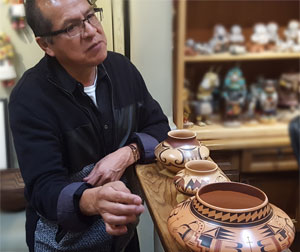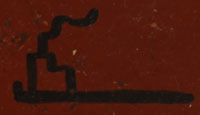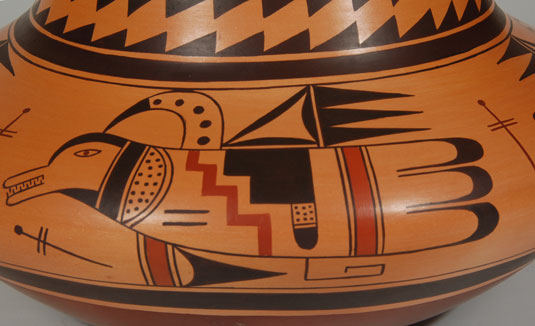Hopi Sikyatki-Revival Polychrome Jar [SOLD]
+ Add to my watchlist Forward to Friend
- Category: Modern
- Origin: Hopi Pueblo, Hopituh Shi-nu-mu
- Medium: clay, pigment
- Size: 5-1/4” height x 10” diameter
- Item # 25910 SOLD
 Sometime around 500 years ago, a very talented potter created a beautiful Sikyatki polychrome jar with a design of a mythical creature that 125 years ago was unearthed in the Sikyatki ruins and was added to the extensive collection of trader Thomas V. Keam. Keam’s collection of prehistoric pottery was catalogued by Alexander M. Stephen, who also assisted Keam in procuring some of the collection.
Sometime around 500 years ago, a very talented potter created a beautiful Sikyatki polychrome jar with a design of a mythical creature that 125 years ago was unearthed in the Sikyatki ruins and was added to the extensive collection of trader Thomas V. Keam. Keam’s collection of prehistoric pottery was catalogued by Alexander M. Stephen, who also assisted Keam in procuring some of the collection.
A very wealthy Victorian Bostonian, Mary Tileston Hemenway (1820-1894) was intrigued with the Southwest and funded two expeditions to the Hopi Mesas in the late 1890s. The First Hemenway Expedition began in 1886 under the direction of J. Walter Fewkes. During the Second Hemenway Expedition Mrs. Hemenway funded the purchase of the extensive Thomas Keam collection of over 4500 items. During the period of this Second Expedition, Mary Hemingway passed away, funding ended, and the expedition came to an end.
The very large collection purchased by her financial generosity was meant to be for a private museum of hers. After she passed away, it was crated and shipped to the Peabody Museum at Harvard University, where it remained boxed and untouched for almost 100 years until it was rediscovered and studied. It then traveled to several museums in 1980-1982 as “America’s Great Lost Expedition—The Thomas Keam Collection of Hopi Pottery from the Second Hemenway Expedition, 1890-1894.”
That magnificent Hopi jar created by that talented potter 500 years earlier was studied and described by Alexander M. Stephen. His description of the design of four bird-like figures is—
The subject, repeated four times, is the mythic Um-tok-ina, the Thunderer. It is depicted with the head of the serpent genius Baholikonga (whose) body is a rain cloud with lightning darting through it, which discloses the origin of the angular cloud symbol so universally depicted upon all classes of their pottery. The tail is that of the eagle; the wings carry storm clouds and attached to the lower wing are the clouds conveying the rain. The singular horn shaped object upon which the hail annulets are incised, passing behind the neck and curving over the head, is the source of thunder. . . The little objects painted upon the vase below the birds are Batolatci (dragon flies) . . . It is told that (a) youth was sacrificed a long time ago and re-appeared a long time afterward during a great drought. He was seen for four mornings just before sunrise extended against the eastern sky. On the fourth day, a great storm arose and the youth, in the form of a gigantic dragon fly, was seen leading the rain clouds over the lands of the Hopitu and the plenteous rains (that) ensued relieved the people from their sufferings.
In 1890, another potter made a jar with a very similar design, a strong indication of the continuation in beliefs of Hopi mythology. This second re-enactment of this mythological belief on a Hopi jar was fortunately early enough to be included in the Hemenway collections. Although the design of the mythological bird-like creature is not a copy of the Sikyatki version, it was inspired by it.
 Now, another 125 years later, there is a third version of this amazing Hopi creation. Mark Tahbo, great-grandson of Hopi-Tewa potter Grace Chapella, was inspired by the two previous jars and created his version of the same. It is not a copy of the two previous jars, but a jar inspired by those. The mythological bird-like figures are similar, but different, with the same elements previously described by Alexander Stephen for the Sikyatki jar. So, there is a Sikyatki pre-historic jar, a later Polacca Polychrome follow-up jar, and now a contemporary Hopi jar to continue the Hopi mythology of the Thunder bird. Mark Tahbo used Sikyatki clay for this new jar.
Now, another 125 years later, there is a third version of this amazing Hopi creation. Mark Tahbo, great-grandson of Hopi-Tewa potter Grace Chapella, was inspired by the two previous jars and created his version of the same. It is not a copy of the two previous jars, but a jar inspired by those. The mythological bird-like figures are similar, but different, with the same elements previously described by Alexander Stephen for the Sikyatki jar. So, there is a Sikyatki pre-historic jar, a later Polacca Polychrome follow-up jar, and now a contemporary Hopi jar to continue the Hopi mythology of the Thunder bird. Mark Tahbo used Sikyatki clay for this new jar.
Condition: new
Provenance: from the artist
Reference: America’s Great Lost Expedition—The Thomas Keam Collection of Hopi Pottery from the Second Hemenway Expedition, 1890-1894 by Edwin Wade, et al.

- Category: Modern
- Origin: Hopi Pueblo, Hopituh Shi-nu-mu
- Medium: clay, pigment
- Size: 5-1/4” height x 10” diameter
- Item # 25910 SOLD



